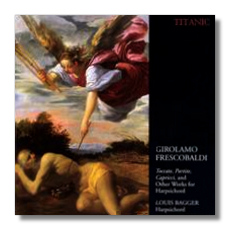
The Internet's Premier Classical Music Source
Related Links
- Frescobaldi Reviews
- Latest Reviews
- More Reviews
-
By Composer
-
Collections
DVD & Blu-ray
Books
Concert Reviews
Articles/Interviews
Software
Audio
Search Amazon
Recommended Links
Site News
 CD Review
CD Review
"How do you like your Frescobaldi?" asked the Hatter. "Al fresco, where the notes patter like summer rain on bare flesh? Or all'interno, where they hover discretely and shimmer like chandeliers?" "Neither sounds like too much fun," said Alice. "That depends," said the Hatter, "on how – or if – you button your collar."
When I first heard Louis Bagger play these Frescobaldi keyboard pieces, I thought his approach was rather dry, academic even. His instrument, a 1969 piece modeled after a 1600 instrument, seems to lack resonance because of its "hollow wrest-plank." I'll stick with my Pierre Hantai version (Astrée E8585), with its close miking and plump tones. After several listenings I had second thoughts. Bagger's approach seems utterly faithful to the text, expressive when needed, but hardly showy. His trills can be delightful but are never unexpected. Performers like Hantai seem more volatile, performing at such a high level of intensity, you can almost see his arms flailing above the instrument. Both harpsichordists interpret the famous Partite Sopra Ruggiero, a set of intricate variations, "each separate with its own tempo and character" (from Bagger's notes). Bagger leaps right into them, eschewing the moody introduction that Hantai favors. Bagger's vivacious approach underscores the dance character of these pieces and when he drops the tempo, it falls rarely below adagio and not for long. His toccata performance benefits from his instrument's odd tone, with its unusually fast decay rate and prominent midtones. However, there is much to be said for Hantai's approach, which gravitates toward the idiosyncratic realm of Glenn Gould. There are more sensuous pauses and pensive gulfs between his allegrettos and adagios. Bagger is a sold craftsman and delivers the product with the relish of a eager scholar. Perhaps gravitation toward his approach depends more on your sensibility than his.
Copyright © 2002, Peter Bates





















